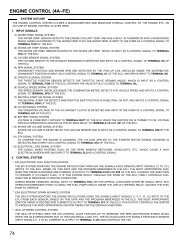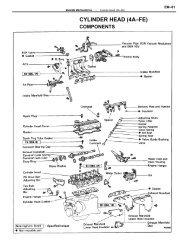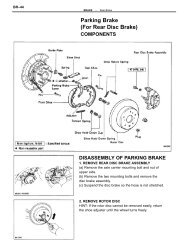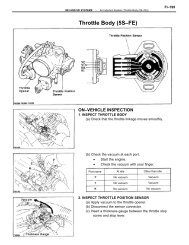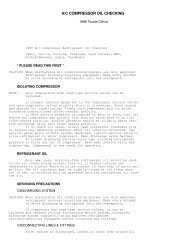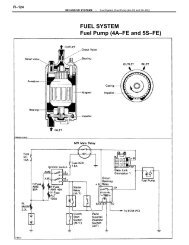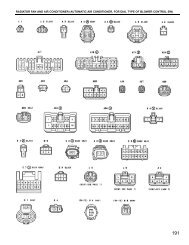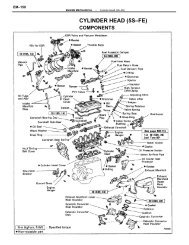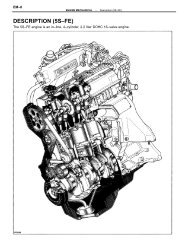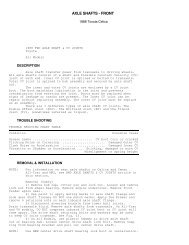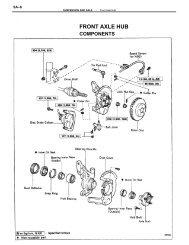turbocharger - CelicaTech
turbocharger - CelicaTech
turbocharger - CelicaTech
Create successful ePaper yourself
Turn your PDF publications into a flip-book with our unique Google optimized e-Paper software.
2) If <strong>turbocharger</strong> appears to be good, but has low boost<br />
pressure, check for the following:<br />
* Gas leaks in exhaust system.<br />
* Deformed or clogged exhaust pipe or muffler which might be<br />
causing increased exhaust resistance.<br />
* Air leaks from compressor discharge side.<br />
WHITE EXHAUST SMOKE<br />
Sustained engine operation with faulty bearings will result<br />
in failure of oil seal which could cause leakage of engine oil into<br />
exhaust and intake pipes. Leakage of engine oil from <strong>turbocharger</strong><br />
into exhaust pipe or intake pipe will result in White colored<br />
exhaust. If this occurs, check for clogged, crushed or deformed oil<br />
return pipe. If nothing is wrong with oil return pipe, leakage is<br />
probably due to wear of piston ring (seal ring) in <strong>turbocharger</strong>.<br />
TESTING<br />
Pressure Check<br />
1) For Camry, connect a 3-way union to boost compensator<br />
pressure hose and install a pressure gauge to it. While driving with<br />
engine running at 2500 RPM or more (accelerator pedal fully depressed<br />
in first gear).<br />
2) For Pickup, connect a pressure gauge to fuel filter.<br />
While driving with engine running at 2400 RPM or more (accelerator<br />
pedal fully depressed in low range). Check the turbocharging<br />
pressure. Standard pressure is 7.7-9.7 psi (.54-.68 kg/cm ) for<br />
Camry and 5.8-7.7 psi (.41-.54 kg/cm ) for Pickup.<br />
3) If pressure is less than specification, first check<br />
intake air and exhaust systems and relief valve for leakage. If there<br />
is no leakage, replace <strong>turbocharger</strong> assembly. If pressure is above<br />
specification, first check if the actuator hose is disconnected or<br />
cracked. If not, replace <strong>turbocharger</strong> assembly.<br />
Intake Air System<br />
Check for leakage or clogging between the air cleaner and<br />
<strong>turbocharger</strong> inlet and between <strong>turbocharger</strong> outlet and cylinder head.<br />
If air cleaner is clogged, clean or replace element. Repair or replace<br />
any collapsed or deformed hoses. Check and repair any leaking<br />
connections. Check and replace cracked components.<br />
Exhaust System<br />
Check for leakage or clogging between the cylinder head and<br />
<strong>turbocharger</strong> inlet and between the <strong>turbocharger</strong> outlet and exhaust<br />
pipe. Repair or replace deformed components. Remove foreign material<br />
in passages. Repair or replace leaking and cracked components.<br />
Actuator & Wastegate<br />
Disconnect actuator hose. Using a pressure gauge, apply 8.2-<br />
8.7 psi (.58-.61 kg/cm ) of pressure to actuator hose and check that<br />
rod moves .0098" (.25 mm) or more. If less, replace <strong>turbocharger</strong><br />
assembly.<br />
CAUTION: Never apply more than 11.4 psi (.8 kg/cm ) of pressure to<br />
the actuator.<br />
Impeller Wheel Rotation<br />
Disconnect air cleaner hose. Grasp edge of impeller wheel and<br />
turn it. Verify that it turns smoothly. If it does not turn or if it<br />
turns with drag, replace <strong>turbocharger</strong> assembly.



